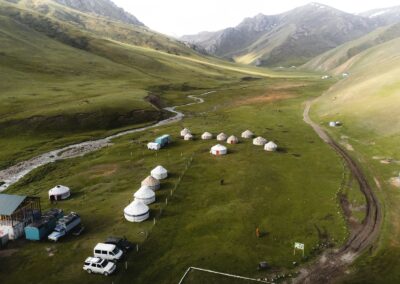Exploring the Advantages of Augmented Reality Travel Guides
Enhanced User Experience through AR
When comparing AR travel guides vs. traditional guidebooks, augmented reality (AR) offers a transformative approach to enhancing the travel experience. Unlike static guidebooks, AR travel guides provide interactive and immersive content that engages users in a dynamic way. This technology allows travelers to view real-time information about their surroundings through their devices, overlaying digital content onto the physical world.
For instance, in a city like Dubai, an AR travel guide can superimpose historical facts, restaurant reviews, or navigational aids directly onto a live view of the cityscape. This not only enriches the travel experience but also facilitates a deeper connection with the destination. Travelers can point their smartphones or AR glasses at landmarks to receive instant, contextual information, making the exploration of new places more intuitive and engaging.
Moreover, AR travel guides offer a level of personalization that traditional guidebooks and mobile apps cannot match. By leveraging user data and preferences, AR applications can tailor content to individual interests, such as highlighting attractions that align with a traveler’s specific hobbies or preferences. This personalized approach ensures that every travel experience is uniquely tailored to the individual, enhancing satisfaction and engagement.
Interactive Features and Real-Time Updates
One of the most significant benefits of AR travel guides is their ability to provide interactive features and real-time updates. Unlike traditional guidebooks, which are limited to pre-printed information, AR guides can offer interactive elements such as virtual tours, augmented maps, and real-time event notifications. This dynamic interaction transforms how travelers access and engage with information.
For example, a traveler exploring Riyadh can use an AR guide to access virtual tours of local museums or historical sites, providing a richer understanding of the destination’s cultural heritage. Additionally, AR guides can offer real-time updates on events, weather conditions, and local news, ensuring that travelers have the most current and relevant information at their fingertips. This immediacy and interactivity significantly enhance the travel experience, making it more responsive and adaptive to changing circumstances.
Furthermore, the ability to interact with digital overlays and virtual elements allows for more engaging and informative experiences. Travelers can participate in interactive scavenger hunts, access detailed 3D reconstructions of historical sites, or even receive live translations of local languages. These interactive features not only make exploring a destination more enjoyable but also provide valuable insights that are not typically available through traditional guidebooks or mobile apps.
Efficient Navigation and Local Insights
AR travel guides also excel in providing efficient navigation and local insights, offering advantages over traditional guidebooks and mobile apps. By utilizing GPS and AR technology, these guides can overlay directional arrows and paths onto the real-world view, helping travelers navigate unfamiliar environments with ease.
In a bustling metropolis like Dubai, where navigating the city can be challenging, AR guides can simplify the process by providing step-by-step navigation instructions directly on the screen. This eliminates the need for cumbersome paper maps or switching between multiple apps. Additionally, AR guides can offer local insights and recommendations, such as nearby attractions, restaurants, or shops, based on the traveler’s current location and preferences.
The integration of local insights into AR guides enhances the overall travel experience by providing contextual information about the surrounding area. Travelers can discover hidden gems, learn about local customs and traditions, and gain a deeper understanding of the destination. This localized approach ensures that travelers make the most of their visit and experience the destination from a more authentic perspective.
Implementing AR Travel Guides in Modern Tourism
Integrating AR Technology into Travel Platforms
To fully leverage the benefits of AR travel guides, integrating AR technology into travel platforms is essential. This involves incorporating AR capabilities into existing travel apps or creating dedicated AR applications that offer seamless and intuitive experiences. Travel companies and platforms can enhance their offerings by adopting AR technology to provide enriched content and interactive features.
For instance, travel agencies in Saudi Arabia and the UAE can develop AR-guided tours that showcase popular destinations and provide immersive experiences for their clients. By integrating AR technology into their platforms, these agencies can offer added value to travelers and differentiate themselves in a competitive market. Additionally, AR integration can improve customer engagement by providing interactive content that captures the interest of tech-savvy travelers.
The successful implementation of AR travel guides requires collaboration between technology providers and travel industry stakeholders. By working together, they can create innovative solutions that meet the needs of modern travelers and enhance the overall tourism experience. This collaboration ensures that AR technology is effectively utilized and delivers meaningful benefits to both travelers and the tourism industry.
Future Prospects and Innovations
Looking ahead, the future prospects and innovations in AR travel guides are promising. As AR technology continues to advance, new possibilities for enhancing the travel experience will emerge. Future developments may include more sophisticated AR interfaces, improved spatial mapping, and even greater integration with other emerging technologies such as artificial intelligence and blockchain.
For business leaders and entrepreneurs in the travel industry, staying abreast of these innovations is crucial for maintaining a competitive edge. By embracing the latest AR advancements and incorporating them into their offerings, businesses can stay at the forefront of the industry and continue to deliver exceptional experiences to travelers. The ongoing evolution of AR technology presents exciting opportunities for enhancing the travel experience and shaping the future of tourism.
In conclusion, AR travel guides offer a range of benefits over traditional guidebooks and mobile apps, from enhanced user experiences and interactive features to efficient navigation and local insights. By integrating AR technology into travel platforms and embracing future innovations, the travel industry can provide more engaging and personalized experiences for travelers, revolutionizing the way we explore and enjoy new destinations.
—
#ARTravelGuidesVsTraditionalGuidebooks #BenefitsOfARGuides #AugmentedRealityTravel #TraditionalTravelGuidebooks #MobileTravelApps #ModernTechnologyInTravel #TravelIndustryInnovations #BusinessSuccess #LeadershipSkills #ProjectManagement #SaudiArabia #UAE #Riyadh #Dubai
























